By Ludwig H. Dyck
The wide tracks of Soviet T-34S and colossal KV-1S crunched through the snow. Night had fallen west of Belgorod on March 15, 1943. The Soviet tank col- umn was headed toward a village, looking for shelter for the night. Although the village appeared deserted, the Soviet commander was wary. For days now there had been heavy fighting, with the Nazis trying to recapture Kharkov from the Soviets. The T-34s fired incendiary shells, setting ablaze a few peasant huts. When nothing moved, the tanks rumbled into the village. The commander’s tank came to halt, unaware that the muzzle of a Tiger tank hidden in a barn was pointed straight at him. Flames shot out of the barn and an 88mm shell smashed into the command tank. Suddenly, the whole village erupted in cannon fire from hidden panzers. Everywhere Soviet tanks were bursting into flames. Panic gripped the Soviet tankers, for they had rec- ognized the hand of enemy commander, Graf Strachwitz, the “Panzer Count,” whose exploits on the Russian front would make him a legend in World War II.
Strachwitz’s story began on July 30, 1893, in Grosstein Castle, when Countess Alexandrine of Matuschka gave birth to a baby boy sired by Hyazinth Graf Strachwitz von Gross-Zauche and Camminetz. As the first-born son in the family and like his father, the newborn was named after the 13th-century Dominican Saint Hyazinth. The Strachwitzes were an old and noble Upper Silesian family, traditionally allied to the Hohenzollern, the dynasty to which belonged the Electors of Brandenburg, the kings of Prussia, and the German emperor.
The young Strachwitz grew up on the agricultural and forest estates of his family, who were among the richest land owners in Silesia. Strachwitz attended the Volksschule and the Gymna- sium of Oppeln. He began his cadet training at the Royal Prussian Junior Cadet School in Wahlstatt and then transferred to the renowned Central Cadet School at Berlin-Lichterfelde. Strachwitz had no problems with academics, excelled at sports and at horse riding, and was a superb fencer.
In 1912 Strachwitz joined the elite Imperial Potsdamer Cavalry Regiment of the Garde du Corps. Before the year was over, Strachwitz’s horsemanship singled him out for further officer training at Hannover’s prestigious Cavalry School. Put in charge of sporting activities, Leutnant Strachwitz and many of his comrades eagerly prepared for the upcoming 1916 Olympics. It was not to be—World War I broke out in 1914.
Soldiers and civilians throughout Europe rejoiced at what they thought would be a short and glorious war. Everywhere people shook Strachwitz’s hand and invited him for beer and sausages. Leutnant Strachwitz exchanged his white Hussar dress uniform for a gray field one and rode off to war at the front of his squadron. Soon the dashing Hussars found themselves stuck in clouds of dust, raised by thousands of infantry and supply wagons.
Strachwitz’s regiment was part of the 1st Guards Cavalry Division and Generaloberst Karl von Bulow’s 2nd Army. Bulow was attacking through Belgium and headed toward the Marne. Carrying out reconnaissance, Strachwitz impressed both his men and his superiors. Even the latter addressed him as Herr Graf, as Strachwitz preferred. Because of his daring, the soldiers nick- named Strachwitz the “Last Horseman.” Soon Strachwitz was awarded the Iron Cross 2nd Class and recommended for the Iron Cross 1st Class.
With the German Army already in northeastern France by late August, Strachwitz volunteered to lead a deep reconnaissance toward Paris. Strachwitz set out early one morning with 16 of his own volunteers. The patrol avoided settlements and stuck to woods and fields but soon happened upon French cavalry. Saber in hand, Strachwitz scattered the chasseurs and freed some German prisoners.
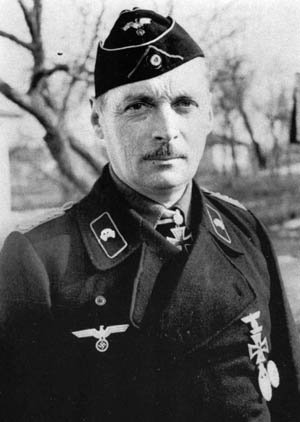
At midday, the way again was blocked. This time the obstruction was a large English camp. Strachwitz’s Hussars burst out of an adjacent forest and through the startled soldiers. With bullets zipping past them, the German cavalry disappeared through the other side as quickly as they had appeared. Strachwitz later joined up with two other German patrols and together they reached Melun by the following morning.
While trying to blow up a railway track, the Germans were stopped by French soldiers. Frightened by the rifle shots, the German horses bolted. Without horses and hunted down by increasing numbers of French and English, Strachwitz’s band became smaller and smaller. Strachwitz nevertheless managed to demolish rail tracks and a signal box near Fontainbleau, causing panic in nearby Paris.
With the way back to the German lines blocked by the alerted French, Strachwitz led his men south in hope of finding a lightly guarded section. They continued walking through muddy ground and pouring rain and they slept under the stars or, if lucky, in a barn. One week after another, Strachwitz’s little group eluded capture. On one occasion, Strachwitz escaped a French company by running up to the crest of a wooded hill. In plain sight, he shouted and pointed for his men to escape to the right. Once on the other side of the crest, Strachwitz and his men ran to the left. The pursuing French were fooled and ran to the right. Unfortunately, during the escape a bullet caught Oberleuntnant Schierstaedt. Seriously wounded, he needed help.
To appear less conspicuous, Strachwitz gave a gold piece to an astonished farmer for some civilian clothes. The count left a whole pouch full of gold when he took a cart and horse from an abandoned barn. Strachwitz needed the cart to transport Schierstaedt but was forced to abandon both when confronted by a French roadblock. The exhausted Germans sought refuge in a wood but were finally caught and overpowered by French Senegalese soldiers.
Strachwitz’s capture in October 1914 was the beginning of a long ordeal fraught with hardship. Because they had been caught in civilian clothing, the French regarded them as spies and saboteurs. Twice it looked like Strachwitz and his men would face the firing squad, but their sentence was five years at hard labor. At Avignon, Strachwitz underwent a year of torture and humiliation. Regain- ing his soldier’s status, Strachwitz was transferred to the German officer prison at Fort Barre. Strachwitz tried to escape by digging a tunnel but was caught. As punishment, he was chained up in the hold of a French ship to deter U-boat attacks. Strachwitz was emaciated by the time he was returned to Fort Barre. As soon as he recovered, Strachwitz joined Oberleutnant von Lossow in another escape attempt. The two climbed the wall, threw a guard off the parapet, and jumped down the other side. Strachwitz landed in barbed wire and tore his foot, but he and Lossow were free.
Strachwitz and Lossow hid in woods during the day, marching at night and avoiding settlements. After two weeks they reached the vicinity of Mont Blanc and the Swiss border. Unfortunately, Strachwitz’s painful wound had become infected. While climbing a rock face, Strachwitz slipped and sustained further injuries. After finding shelter in a cabin, he unsuccessfully pleaded with Lossow to abandon him. Detected by locals, the two fugitives were apprehended by gendarmerie.
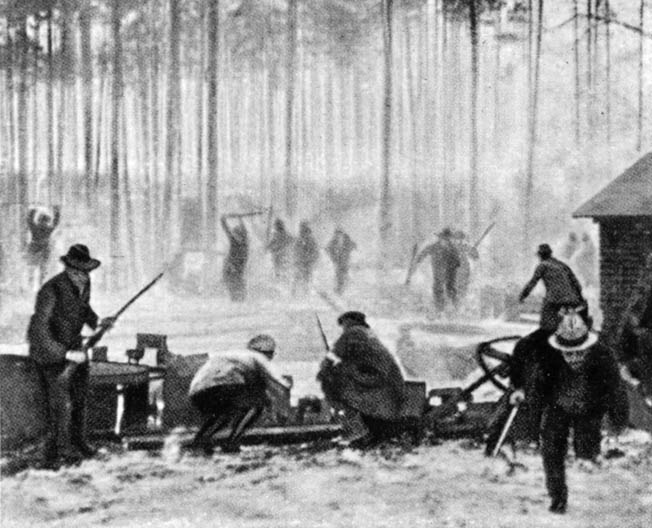
Strachwitz ended up in the officer prison at Carcassonne in southwestern France where he recovered sufficiently to saw at the window bars with a homemade file. Betrayed by an informant, Strachwitz was thrown in solitary. His untreated wound got worse but proved to be his salvation when an inspecting Swiss doctor demanded that the fever-ridden Strachwitz be handed over to the Swiss Red Cross. As his health improved in a Geneva hospital, Strachwitz avoided being returned to France as a prisoner by faking mental illness. Confined at Herisau Institute, the mental anguish of the inmates nearly drove Strachwitz to suicide. After the war ended on November 11, 1918, Strachwitz was released.
With German Emperor Wilhelm II being forced to abdicate, Germany plunged into civil strife. Strachwitz arrived in Berlin where the fledgling republic was threatened by communist revolutionaries. Joining government loyalist troops, Strachwitz took part in the weeks of fighting that lasted into January 1919.
Silesia had been part of Prussia for nearly two centuries. Before Prussia it had been ruled by the Austrian Habsburgs, and before them by Bohemia; however, for most of the Middle Ages, Upper Silesia had been Polish. With the recreation of Poland after World War I, the Poles wanted Upper Silesia to become part of Poland again. Token French, English, and Italian garrisons were supposed to keep the peace between the Germans and the Poles but mostly stayed neutral or, in the case of the French, actively supported the Poles. During these uncertain times, Strachwitz remained active in the illegal militia while managing the family estate. In July, Strachwitz married Alexandrine “Alda” Freiin Surma-Jeltsch, who nine months later gave birth to their son.
In March 1921 Upper Silesia voted whether to remain in Germany or be ceded to Poland. Although the German vote won, the region that voted Polish was allowed to join Poland. Unsatisfied, militant Poles led by Wojciech Korfanty tried to seize the German territory as well. At Gross Stein, Strachwitz awoke to gun shots and the sound of refugees fleeing from the advancing Poles. Strachwitz brought his family, including his pregnant wife, to safety then hurried back to join the German resistance.
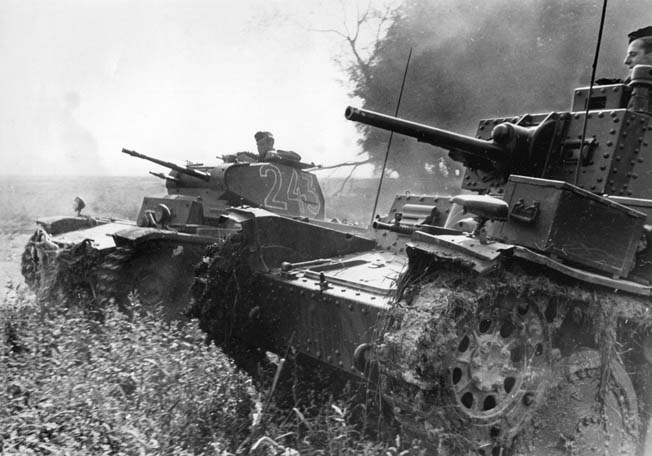
Although the Poles outnumbered the Germans, the Germans had more combat experience and were buffered by paramilitary Freikorps. Leading a counterattack, Strachwitz fought off eight Polish companies and retook his ancestral castle. The fighting climaxed on May 21, 1921, with the iconic Battle of Annaberg. While the bulk of the German forces under Generals Karl Hofer and Bernhard von Hulsen
Upon his return to Gross Stein castle, Strachwitz found more strife in his homeland. Upper attacked the Polish-held mountain from the front, Strachwitz led his men around to the rear. Strachwitz forced the Poles on the summit to surrender after a short but violent fight. In the ensuing battles, Strachwitz captured an artillery battery and turned the guns against the fleeing Poles. The conflict was finally settled in 1922 with Germany retaining the western two thirds of Upper Silesia while the industrial eastern third was ceded to Poland. Strachwitz received the Silesian Order of the Eagle, both second and first class.
During the interwar years, Strachwitz moved his growing family to Alt Siedel manor. He educated himself in forest management and modern methods of agriculture. In 1931 Strachwitz joined the Nazi Party, reckoning that doing so would benefit his Silesian homeland. Two years later he was admitted into the Schutzstaffel (SS), which was eager to have aristocrats in its ranks; however, Strachwitz never served in the SS and remained a reserve officer under the command of the new Wehrmacht. The latter made Strachwitz Rittmeister der Reserve (Cavalry Master of the Reserve) in 1936.
When Hitler invaded Poland on September 1, 1939, Strachwitz was put in charge of supply and reinforcement for the 1st Panzer Division’s 2nd Panzer Regiment. Despite his rear-echelon position, he participated in the fighting and earned the Iron Cross Second Class. To help the wounded, Strachwitz allowed Gross Stein to be used as a military hospital. Back at Alt Siedel by mid-October, Strachwitz returned to his division at the end of the year.
During the six-week-long Battle of France in the spring of 1940, the 1st Panzer Division spearheaded General Heinz Guderian’s XIX Panzer Corps’ fateful drive through the Ardennes to the coast of the English Channel. At the start of the offensive, a young officer asked Strachwitz if he hated the French. In spite of his bad experiences, Strachwitz replied that he had no hate and that he respected the French as soldiers, who ceased to be his enemy once they were defeated.
On the morning of May 14, French aircraft struck the German crossing of the Meuse Bridge. Strachwitz directed traffic and ordered the men to take cover. After the German break through over the Meuse, Strachwitz set out with his Kubelwagen and driver for a reconnaissance. Nineteen miles into French territory, they pulled up to a French signals garrison. Strachwitz got out of the car, calmly lit a cigarette, and demanded the surrender of the garrison in perfect French. He told the captain that his panzers were only minutes away. The bluff worked and 600 French soldiers surrendered. Strachwitz delivered the captives in their own new trucks. “Strachwitz, that devil” said General Friedrich Kirchner of the 1st Panzer Division upon learning of the feat. Promoted to major, Strachwitz was awarded the Iron Cross 1st Class in June.
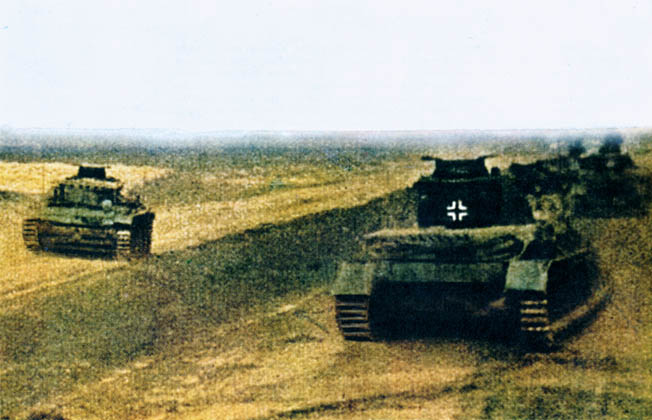
Strachwitz was on another excursion when he watched the embarkation of the British Expeditionary Force at Dunkirk. He was dumbfounded by Hitler’s order to halt the panzers in favor of air strikes. The miraculous British evacuation was soon eclipsed by the fall of France, however. Alongside the 2nd Panzer Regiment, Strachwitz was transferred to East Prussia and to the new 16th Panzer Division led by Generalmajor Hans-Valentin Hube.
The one-armed general clapped Strachwitz on the shoulder, granted Strachwitz’s frontline request, and assigned him the 1st Battalion of the 2nd Panzer Regiment, 16th Panzer Division. Strachwitz briefly took part in the invasion of Yugoslavia before being withdrawn to prepare for Operation Barbarossa, the invasion of the Soviet Union on June 22, 1941.
At the outset of the invasion, the 16th Panzer Division was in the forefront of Paul Ludwig Ewald von Kleist’s First Panzer Group, which had as its initial objective the Ukrainian capital of Kiev. On June 26, Kleist was more than 75 miles into Soviet territory when Col. Gen. Mikhail Kirponos launched a spirited counterattack. In the hills west of the Ikwa River, 2nd Panzer Regiment sallied forth to intercept masses of Soviet tanks. Amid deafening explosions, fountains of earth, and clouds of smoke, an adjutant reported to Strachwitz that they were T-26 light tanks. Strachwitz’s Ullstein Bild binoculars zeroed in on more Soviet tanks in the woods to the rear. He ordered the heavier Mark IVs to counter the Soviet outflanking attempt. Soviet infantry swarmed through the panzers. A bullet grazed Strachwitz’s arm. Roughly bandaged, the wound continued to bleed into the cloth. At dusk, after hours of fighting, the Soviets were thrown back but the regiment had been cut off from the division.
It was only the first day of the largest tank battle of Barbarossa so far. The panzer guns proved to be nearly impotent against the new Soviet T-34s and KV-Is. The Germans made up for it with superior tactics, Junkers Ju-87 Stuka support, and tank-busting 88mm guns. Strachwitz drove back attacking tank packs, chased them into the night, and shot up Soviet batteries. The battle wound down at the beginning of July, with Kirponos withdrawing toward Kiev.
The First Panzer Group headed south, intending to link up with Seventeenth Army and trap Soviet forces in a pocket at Uman, 200 miles south of Kiev. During the ensuing fighting, Strachwitz had his panzers move their guns to a six o’clock position in Soviet fashion, which enabled him to ambush the enemy or wreak havoc behind their lines. Strachwitz sustained additional minor wounds in the head and the arm. The regiment had suffered as well. Its remaining panzers were combined into one battalion led by Strachwitz.
On August 3, while attempting to secure the bridge over the Southern Bug at Pervomaisk, Strachwitz’s panzer took a direct hit by an artillery shell. The radio operator was killed but Strachwitz and his remaining crew were able to crawl out of the smoking wreck. Fighting off Soviet infantry with MP-40s and grenades, Strachwitz climbed into the next panzer. He led his battalion to the wooden bridge that the Soviets were trying to blow up. The panzers opened fire to cover the German pioneers storming across. The Soviets pulled back, but they maintained a withering fire. The pioneers struggled to disassemble the demolition charges until Strachwitz sped across the bridge with his panzer.
The Battle of Uman ended in another German victory. Six weeks into Barbarossa, Strachwitz’s panzers had covered 440 miles but the steppes of the Ukraine seemed endless. Sixteenth Panzer Division pushed toward the Black Sea, where Nikolajew fell on the eve of August 16. Late in August, the division was back north, resting south of Kirovograd. On August 25, Hube awarded Strachwitz with the Knight’s Cross.
Restored to two battalions, Panzer Regiment 2 returned to action in September as part of the southern pincer of the Kiev encirclement. On September 16 the gigantic pocket of the Dnieper bend was closed 130 miles east of Kiev. Strachwitz’s battalion engaged Soviet troops desperately trying to break through to the east. When a Soviet division commander of German ancestry was captured, Strachwitz refused to take him prisoner unless the commander returned with his whole division. The next morning 7,000 men marched out of the nearby wood and into captivity. They were among the 663,000 Soviet prisoners captured at Kiev.
Strachwitz did his best to treat the prisoners well and also helped ailing farmers, women, and children. Often his men repaired local churches, further endearing him to the population. Unfortunately, Strachwitz’s goodwill and that of others like him was undone by Nazi terror in conquered areas. Most of the prisoners ended up starving to death or were executed, fueling hate and hardening resistance.
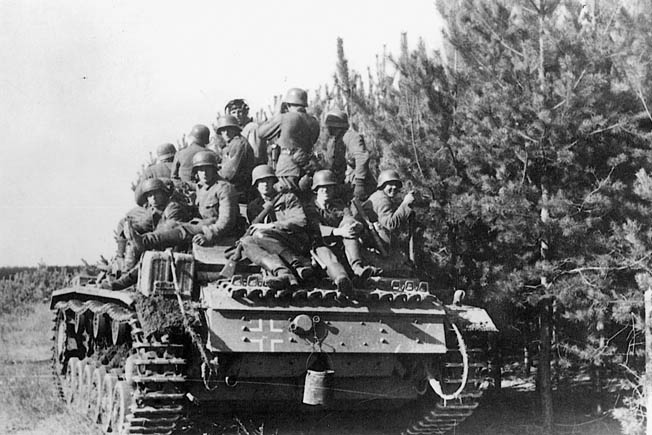
Upgraded to First Panzer Army, the former First Panzer Group attacked the Soviet Dnieper Front from the north in late September. On October 6 Strachwitz’s battalion captured the main road junction of Andrejewka, closing one of the last links of another huge encirclement. On October 9 the temperature dropped and falling snow obscured the view. Fighting to seal off penetrations, Strachwitz was again wounded in the head. Cutting short his field hospital stay, he returned to the front on the same day.
After the successful conclusion of the cauldron battle north of the Azov Sea, First Panzer Army pushed toward Rostov. The remaining panzers of the depleted 2nd Panzer Regiment were again amalgamated under Strachwitz’s command. At the end of October, rain, snow, and slush turned roads into swamps. Supplies slowed down and vehicles were stranded without petrol. While Strachwitz’s panzers underwent repairs at Uspenkaja, a Soviet bomber hit a camp of their own prisoners. Distraught at the carnage, Strachwitz moved the Soviet prisoners farther behind the front lines.
The temperature plummeted, freezing anything stuck in the mud. Alongside 5th SS Panzer Division Wiking, the 16th Panzer Division engaged a Soviet counterattack. Strachwitz rescued a Wiking pioneer battalion cut off at Balabanow. By November 23, 2nd Panzer Regiment only had 20 panzers left and was forced to fall back to the west bank of the Mius River. Strachwitz left for Germany to recover from his many combat wounds. Meanwhile, the German Army withstood the fierce Soviet winter offensive of 1941-1942 and the extreme weather that wreaked havoc among the ill-equipped troops.
Strachwitz was back with his regiment in March 1942, promoted to Oberstleutnant and awarded the wound badge in silver. On May 12 the Soviets renewed their push for Kharkov. Kleist’s panzer army riposted, attacking from south of Izyum to slice off the southern pincer of the SouthWest Front. On May 23, Strachwitz’s battalion met the 23rd Panzer Division south of Balakleya. Marshal Semyon Timoshenko’s armies were encircled. Alongside several officers standing on a small rise of ground, Strachwitz observed columns of Soviets trying to break out. Warned by his uncanny instinct, Strachwitz suddenly grabbed the arm of the adjacent Hauptmann Freytag von Loringhoven and jerked him downhill. In the next instant a shell exploded where they had stood, killing the others.
A brief period of rest followed the German victory at Izyum. Around this time Strachwitz took over command of the entire regiment, which from June 10 onward took part in the preliminary battles for Case Blue, the massive German summer offensive of 1942. Through drenching rainstorms and seas of mud, Strachwitz engaged more Soviet armor and fought off night attacks. The 16th Panzer Division captured the heavily fortified city of Kupjansk in mid-June. During the fighting, a shell splinter struck Strachwitz’s head. He had the wound provisionally treated, then quickly returned to his men.
On July 8, once more rested and refitted, 16th Panzer Division took part in Sixth Army’s drive for Stalingrad on the Volga River. Assault- ing the Soviet bridgehead over the Don River west of Kalach in late July, Sixth Army won its last great encirclement battle. Armor combat raged through the villages and on the heat- scorched grass steppes, mirrored by equally fierce aerial engagements in the sky above. Strachwitz was again wounded. His regiment breached one of the last Soviet defenses north of Kalach, enabling the linkup with 24th Panzer Division. During the battle, Strachwitz’s regiment claimed 270 enemy tanks destroyed.
After waiting out a morning barrage of Soviet artillery and rockets on August 23 in a foxhole, Strachwitz led his panzers in XIV Panzer Corps’ final 35-mile drive to Stalingrad. Henschel Hs-129 and Ju-87 ground attack aircraft opened the way for 400 panzers, breaking all resistance. Upon approaching the northern suburbs, the Soviets used their heavy antiaircraft guns in a ground fire role against Strachwitz’s panzers. With the help of Stukas, Strachwitz destroyed 37 of these antiaircraft guns without suffering a loss. The Germans were shocked to discover that the mangled gun crews were women, poorly trained in engaging ground targets.
Strachwitz led his panzers down a street, driving along the edge in case the road was mined. A hidden antitank gun opened up, barely missing Strachwitz’s panzer. The Soviet gun was quickly knocked out, and Strachwitz kept going until he reached the high western banks of the Volga. He marveled at the spectacle of the city and river below. With the exception of the onion shaped cathedral spires of the old town, Stalingrad was a modern industrial city. Factories, smokestacks, and suburbs extended in a narrow strip along the Volga. Clouds of smoke from bombing Stukas and Soviet antiaircraft guns drifted over the whole scene. The river was full of boats against which Strachwitz directed his panzer cannons, sinking several vessels.
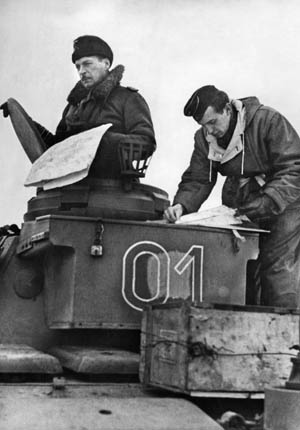
Ordered to help defend the northern industrial suburbs, Strachwitz hid his three companies at the bottom of a long hill. Multiple waves of Soviet armor obstinately attacked over the crest. At a range of 300 to 500 yards, the panzers knocked out more than 100 tanks in two days. “Our Panzer Count only needed to sit behind the front in his command tank, which had a wooden dummy gun, tallying up the knocked out enemy tanks reported by the companies,” said von Loringhoven. Heavy fighting for the northern sector continued through September into October, with Hitler insisting on capturing positions no matter what the cost. On October 13 Strachwitz’s panzer received a direct hit. Severely burned, Strachwitz was flown to the Reserve Hospital at Breslau. He was still recuperating when the Soviet counteroffensive in late November encircled the doomed German Sixth Army. Strachwitz pleaded to return to the front but, realizing the hopelessness of the situation, General Hube refused.
Strachwitz received the Oak Leaves to his Knight’s Cross in December and a promotion to Oberst der Reserve on January 1, 1943. His new command was the panzer regiment of the elite Panzer Grenadier Division Grossdeutschland. On March 9 Strachwitz’s regiment joined Field Marshal Erich von Manstein’s counterattack against the overextended Soviets at Kharkov. West of Belgorod, Grossdeutschland squared off against three Soviet tank corps.
The fighting included an intense night battle on March 15-16. Having seen the dark silhouettes of Soviet tanks against the snow converging on his position, Strachwitz hid his panzers, including three Tigers, in a deserted peasant village. In a horseshoe formation, camouflaged, dug in, or hidden in the thatched huts, the panzers waited until nightfall. The rumbling of as many as 50 Soviet tanks resounded through the dark. A few huts were hit by incendiary shells and burst into flames.
Strachwitz remained calm, letting the whole Soviet column enter the village. With a Soviet command tank within 70 meters, Strachwitz’s hidden Tiger fired and blasted the turret right off the T-34. The other panzers let loose, knocking out 18 T-34s and KV-1s in a few minutes. Strachwitz climbed on top of his turret and watched the inferno. “The Russians have recognized us, they’re broadcasting, ‘Watch out, it’s Strachwitz,’” said Strachwitz’s radio operator. The Soviets desperately tried to pull out but were shot up in the process. The Soviet losses were only part of the more than 300 Soviet tanks knocked out by Strachwitz’s regiment between March 14 and March 19.
Strachwitz was awarded the Swords to his Knight’s Cross on March 28. His soldiers honored him by substituting Strachwitz’s name for that of the Napoleonic-era Lutzow in the popular soldier’s song “Lutzow’s Wild, Venturous Hunt.” Strachwitz took two weeks of hol- iday visiting Berchtesgaden with his wife Alda. Appearing on a radio show, Strachwitz accredited his successes to the close cooperation, the high skill level, and the total commitment of every single man in his regiment.
During Operation Citadel, the German summer offensive of 1943, Grossdeutschland fought as part of Fourth Panzer Army, forming the southern pincer during the Battle of Kursk. Morale among the soldiers was high, not the least because Strachwitz was fighting with them. “I remember how much talk there was among us that we had nothing to fear, because we had Graf von Strachwitz and his new, invincible Panther tanks with us,” said Grossdeutschland fusilier Alfred Novotny.
A heavy rain fell on July 5 as massive artillery salvos opened the battle. Grossdeutschland fought its way through the deep Soviet defenses of minefields, antitank guns, and dug-in tanks north of Belgorod. Strachwitz took over command of Panzer Brigade 10, which included his own regiment and Panzerregiment 39 with its new Panthers, from July 7 to July 11. The fighting on July 7 alone accounted for 62 Soviet tanks and 55 antitank guns destroyed, but Soviet resistance stiffened toward the Oboyan Heights.
On July 9 Strachwitz received the news that his oldest son had been seriously wounded. The day after, Strachwitz was resting his arm on the breech lock when his new gunner fired prematurely, smashing the count’s arm. Receiving a plaster cast, Strachwitz hurried back to his regiment, led another attack, and received another light wound. Outraged at Strachwitz’s self-sacrifice, Generalleutnant Walter Hoernlein sent the count back to the field hospital.
Strachwitz returned to combat in August. The Battle of Kursk had meanwhile ended in a German defeat, forcing the German Army to withdraw ever farther westward. So severe was the fighting that Strachwitz only had one operational panzer by the end of September. By late December, Grossdeutschland was across the Dnieper River at Kirovgrad. Strachwitz received another serious wound, this time in the left arm. After being sent to Breslau hospital, he completed his convalescence at home.
Early in January 1944, Strachwitz was promoted to Hoheren Panzerführer (Higher Panzer Commander) of Army Group North. The northern German front had fallen back to the city of Narva, the gateway to Estonia. Strachwitz sought to eliminate the Soviet bridgehead over the Narva River at Krivasso. The bridgehead was so large that it needed to be divided into three parts and eliminated one part at a time.
On March 26, Strachwitz attacked head-on as swampy wooded terrain precluded any out- flanking. Spearheading the attack in one of the first three Panzer IVs, Strachwitz was nearly hit by friendly fire from a Stuka. The fighting continued through the night in dark, claustrophobic conditions. Walking stick in hand, wearing his trademark sheepskin jacket, Strachwitz was always at the front, keeping up on the latest battle developments and insuring sufficient supplies. He handed out cognac and chocolate, offered encouragement, and awarded Iron Crosses. It took several days of hard fighting until the Soviets were defeated.
Promoted to major general of the reserve on April 1, Strachwitz prepared for the attack on the next portion of the bridgehead. This time the terrain allowed the use of the Tigers of Heavy Panzer Battalion 502. “[Strachwitz] won our confidence from the very beginning,” said Panzer ace Leutnant Otto Carius of Battalion 502. Strachwitz “was one of those personalities who one could never forget,” he said.
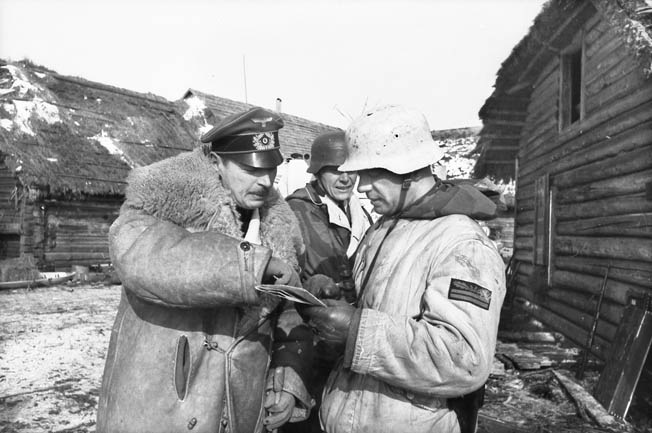
Carius’s Tigers took the lead, shielding the fusiliers following behind. Soviet small arms fire ricocheting off the Tigers, but ripped into some of the fusiliers. Contact was established with German troops trapped in the pocket. At night, Soviets hidden in the forest ambushed German infantry and armored personnel carriers. Nevertheless, by April 9, after four days of intense fighting, the last Soviet resistance was eliminated.
The last of the bridgehead still remained, however, and it was nearly twice the size of the previous ones. Strachwitz directed the offensive via radio in a bunker, which the Soviets continued to shell. This time, though, the Soviets were alert, their defenses were too strong, and the spring melt had begun. After three days, on April 21, the offensive had to be called off.
In recognition of Strachwitz’s initial successes, Hitler presented him with the Diamonds to the Knight’s Cross. Strachwitz bluntly rejected Hitler’s request to eliminate the remaining bridgehead. “Panzers can’t drive in the swamp,” Strachwitz told Hitler. Strachwitz continued to lead infiltrating actions on the southern flank of Army Group North. Penetrating 90 miles into enemy territory, Strachwitz burst upon an unsuspecting Soviet tank lager, blowing up tank after tank and spraying their startled crews with machine-gun fire.
There was no stopping the Soviet juggernaut, though, when, on June 22 Operation Bagration overwhelmed the undermanned and under-equipped lines of Army Group Center. Strachwitz was part of the relief attempt of Vilnius, making it possible to evacuate thousands of wounded soldiers before the city fell to the Soviets on July 13.
A significant event occurred that month at Hitler’s headquarters in East Prussia. On July 20 Major Claus von Stauffenberg planted a bomb at the Wolf’s Lair in a failed attempt to assassinate Hitler. At the time, Strachwitz was nursing a leg wound in Silesia. Many of Strachwitz’s acquaintances and friends were arrested and interrogated. The count tried to intervene but came under suspicion himself. When the Gestapo questioned Strachwitz’s Catholic religion and connections, Strachwitz admonished them for their Nazi atheism.
Strachwitz was soon needed back at the front. On August 1 the Soviets reached the Gulf of Riga at Tuckum, stranding 30 German divisions in northern Latvia and Estonia. In Operation Double Head, Third Panzer Army sought to reestablish contact by recapturing Tuckum and coming to the relief of beleaguered Riga. “If anyone can do it, it’s Strachwitz,” said Chief of Staff Heinz Guderian upon being informed that Strachwitz was to spearhead the attack.
On August 18, Strachwitz’s battle group advanced from of Frauenburg, East Prussia, crossing Lithuania on its way to Tuckum. Strachwitz’s command consisted of about 2,500 Waffen-SS and Wehrmacht soldiers and 60 panzers, mostly new Panthers from Panzer Brigade 101. There were also a couple of Tigers from the 103rd SS Heavy Panzer Battalion, Mark IIIs and IVs of SS Brigade Gross, and armored personnel carriers and flak units.
At a bridge west of Tuckum, the surprised Soviet battalion gave up without a fight. Reaching the outskirts of the city on August 20, Strachwitz called for support from the cruiser Prinz Eugen in the Gulf of Riga. Prinz Eugen’s 203mm guns and the guns of several destroyers zeroed in on Tuckum’s market square, obliterating dozens of parked T-34s. Strachwitz’s panzer entered the city, driving by charred tanks. Some were overturned and their crews dead and burned. As for the survivors, they were too dazed to fight back. A few remaining tanks were easily dispatched. With SS Brigade Gross holding Tuckum, Strachwitz intercepted an approaching Soviet convoy. Believing themselves surrounded, the whole convoy surrendered.
Strachwitz pushed on to Riga with his grenadier battalions and his nine remaining Panthers, as many of the Panthers had broken down. After further engagements in a wood, Strachwitz entered Riga on the August 21. Driving by cheering Latvians and German troops, the count’s Panther stopped in the marketplace right in front of a number of high-ranking officers. In his sweat and dirt-stained overalls, his face smeared in oil, Strachwitz emerged from the cupola. “Hurrah, Leutnant, you have busted the cauldron,” called out an officer. To astonished gazes, Strachwitz replied that he was a full fledged general.
Grossly overestimating Strachwitz’s force, the Soviet Fifty-First Army claimed that Tuckum had been attacked by 300 tanks. In three days, Strachwitz’s small battle group had captured 18,000 prisoners and destroyed numerous artillery pieces, tanks, and antitank guns. The wounded could be evacuated out of Riga and contact had been reestablished, albeit only temporarily, with Army Group North.
On August 24, 1944, Strachwitz was nearly killed in a traffic accident. Knocked unconscious, he woke up two weeks later in Riga hospital. He could hear the Soviets firing artillery at the city. Some rounds hit the hospital, but Strachwitz’s injuries prevented his transport. It was not until early October, with the fall of Riga imminent, that Strachwitz was flown to Breslau. The doctors counted on keeping him hospitalized for eight months. Strachwitz left after only seven days, continuing his recovery at Alt Siedel.
With the Soviets surging into Silesia on January 16, 1945, Strachwitz showed up at Field Marshal Ferdinand Schorner’s Oppeln headquarters on crutches. Strachwitz asked to return to the front to defend his homeland. Even Schorner, who sent anyone remotely combat-worthy to the front, was stunned. Schorner needed someone to organize tank hunters armed with panzerfausts. Strachwitz undertook the effort. Within a few weeks, 8,000 men volunteered. The force included hardened veterans, returning wounded, and idealistic teenagers. The desperate nature of the final days of fighting was embodied by Strachwitz’s youngest son, Hubertus Arthur, who despite being a leg amputee, volunteered to return to the front and was killed on March 25.
After Germany’s surrender on May 8, Strachwitz ensured that most of his soldiers ended up in American captivity. A still limping Strachwitz surrendered to an American lieutenant in Felgen. The count looked so haggard that the lieutenant thought he needed medical help. Taken to the Allendorf, Strachwitz found himself in the company of several hundred German officers, includ- ing Guderian and Adolf Galland. They were treated well and used to gain records of the war and military tactics. Strachwitz spent two years in captivity, during which he received the disheartening news that his wife Alda had been killed by a U.S. military truck.
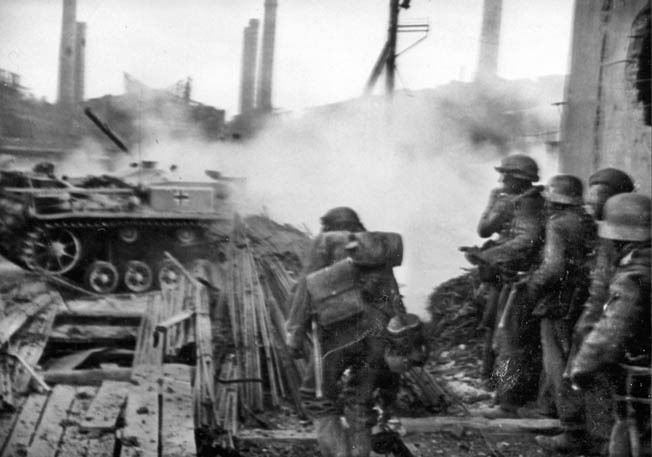
Upon regaining his freedom in the spring of 1947, Strachwitz no longer had a home to which he could return. His ancestral lands in Upper Silesia had been occupied by Russians who later handed them over to Poland. His tattered uniform and his medals were all that Strachwitz had left. In a fresh start to a new life, Strachwitz married again. His bride was the much younger Nora von Stumm. After two years abroad beginning in 1949, the couple eventually returned to Ger- many, settling in upper Bavaria. Strachwitz founded a refugee foundation for displaced Silesians and became a Knight of Devotion of the Order of St. John.
On April 25, 1968, the 75-year-old Strachwitz, who was a heavy smoker, succumbed to lung cancer. “It was because of his bravery, which served as an example to all officers and soldiers, that he carried the highest decorations of the Knight’s Cross, the Oakleaves, the Swords and the Diamonds,” said General Heinz-Georg Lemm of the Bundeswehr, himself a holder of the Oak Leaves and Swords, at Strachwitz’s funeral. Unlike most senior commanders of the Third Reich, Strachwitz was buried with full military honors.
Strachwitz’s motto was, “Panzers should not be standing around, they should be rolling along, either shooting at the enemy or attacking and pursuing.” With speed and daring and a knack for improvisation and organization, Strachwitz achieved victories against great odds. Strachwitz was wounded 14 times, but he proved as tough as the wild boar on the Strachwitz coat of arms. Guderian rightly considered Strachwitz to be one of the greatest panzer leaders
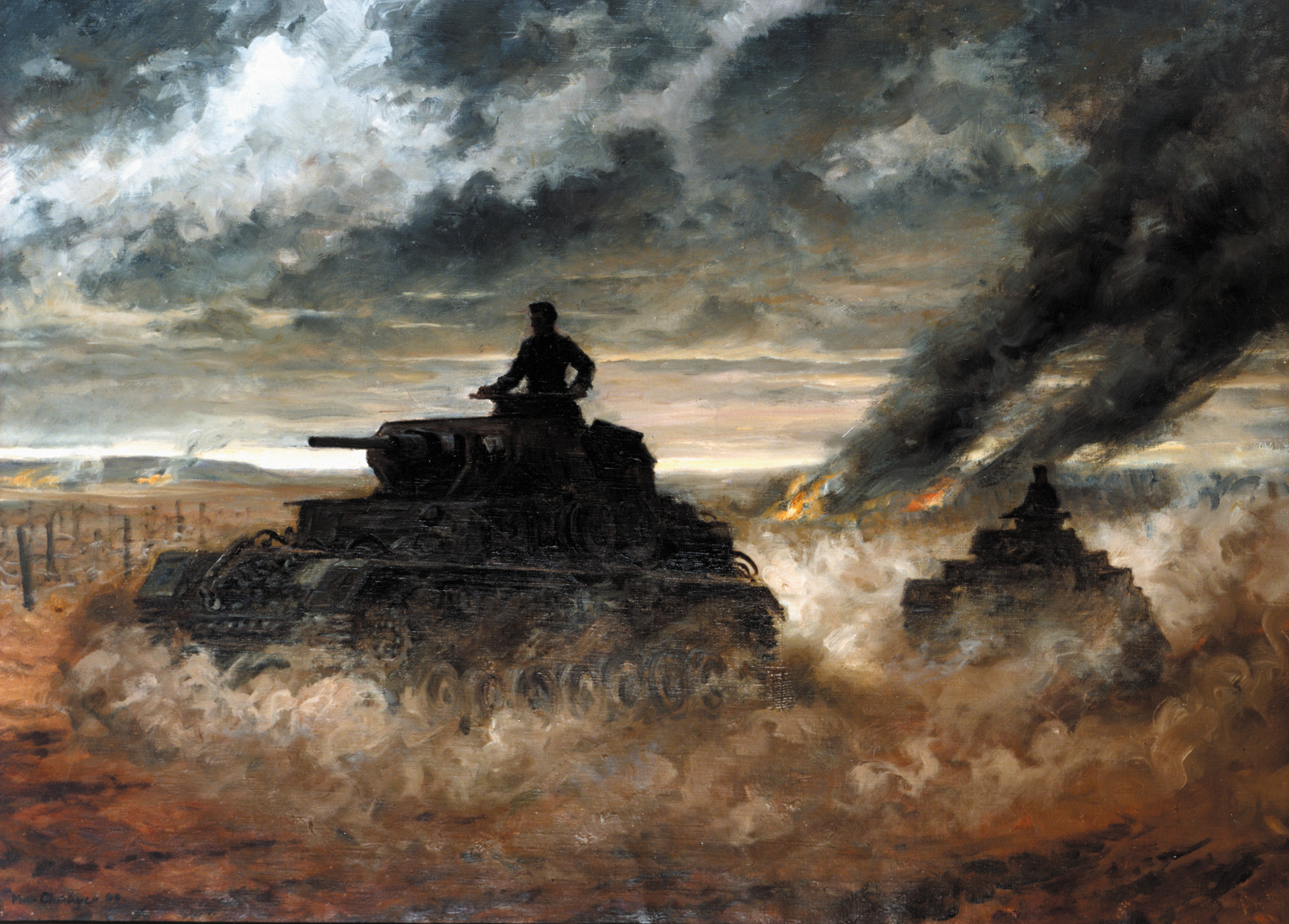
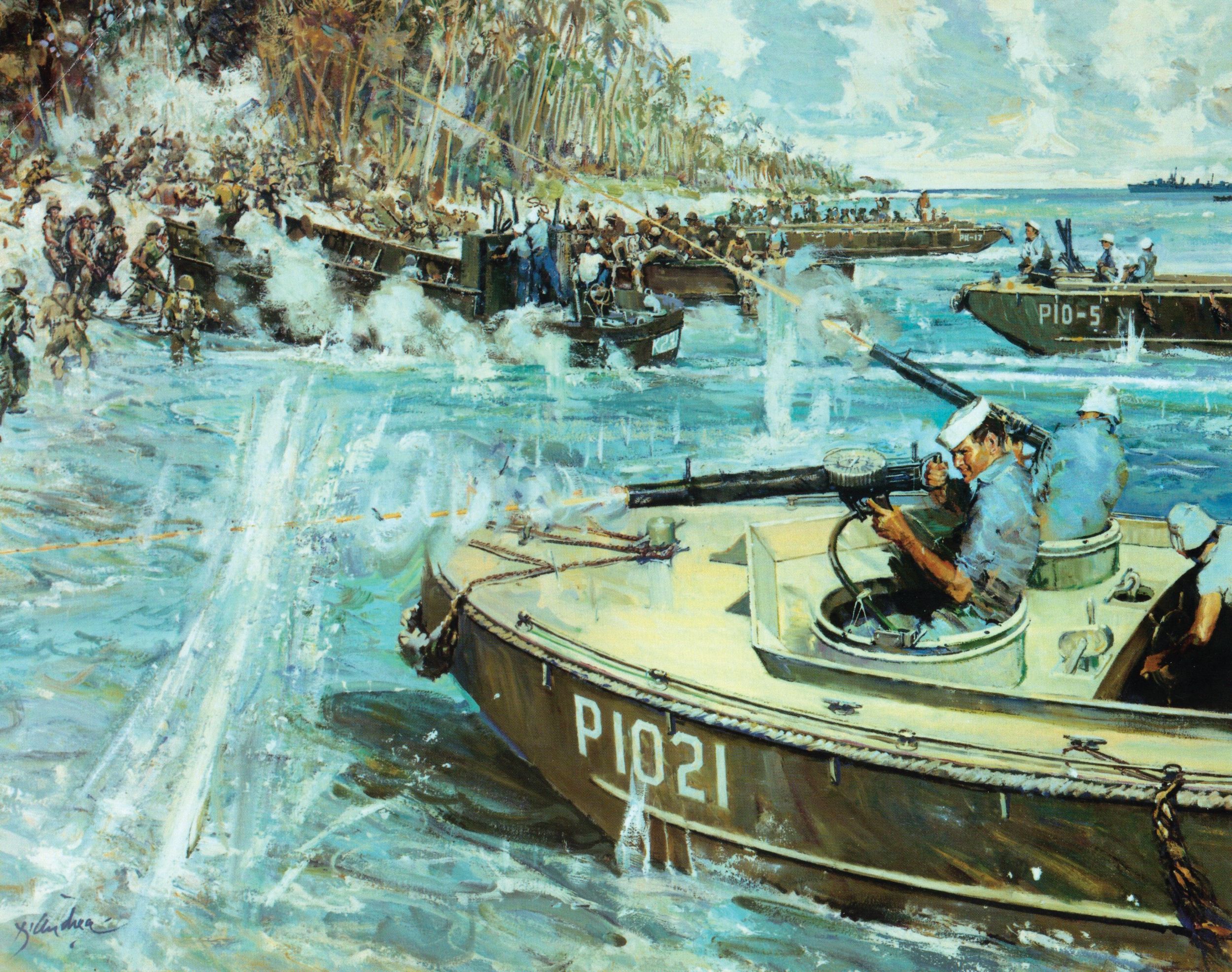
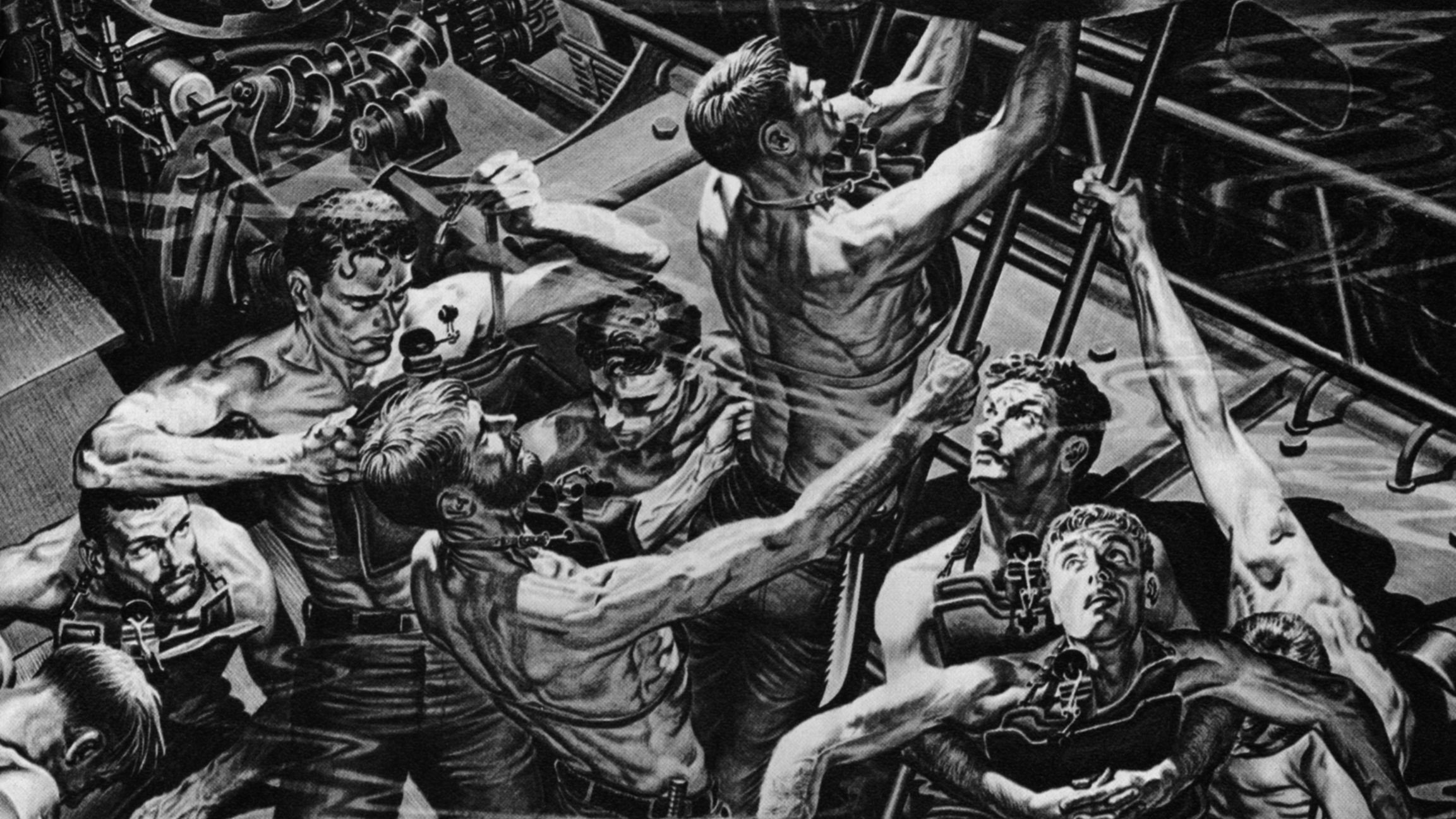
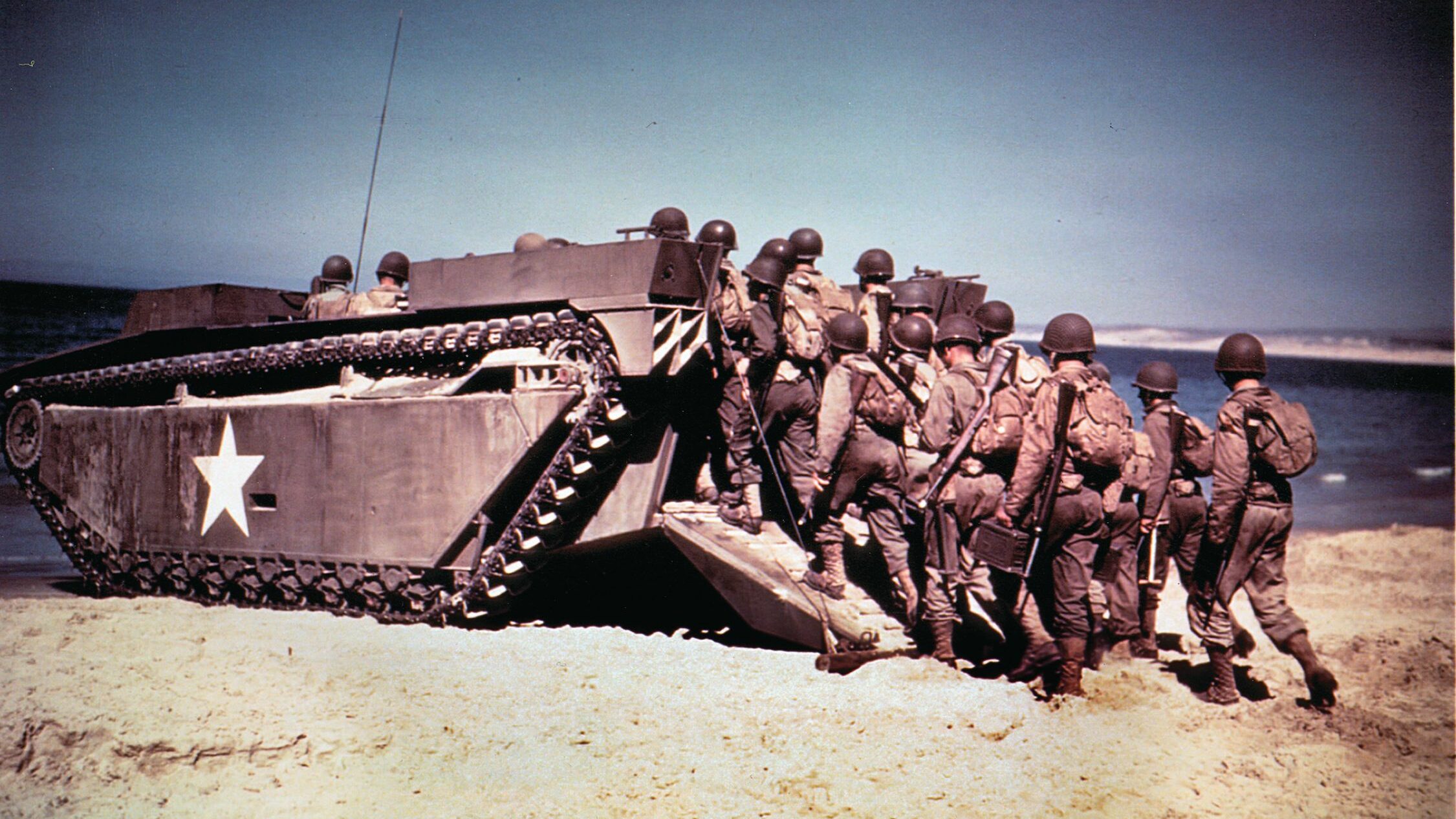
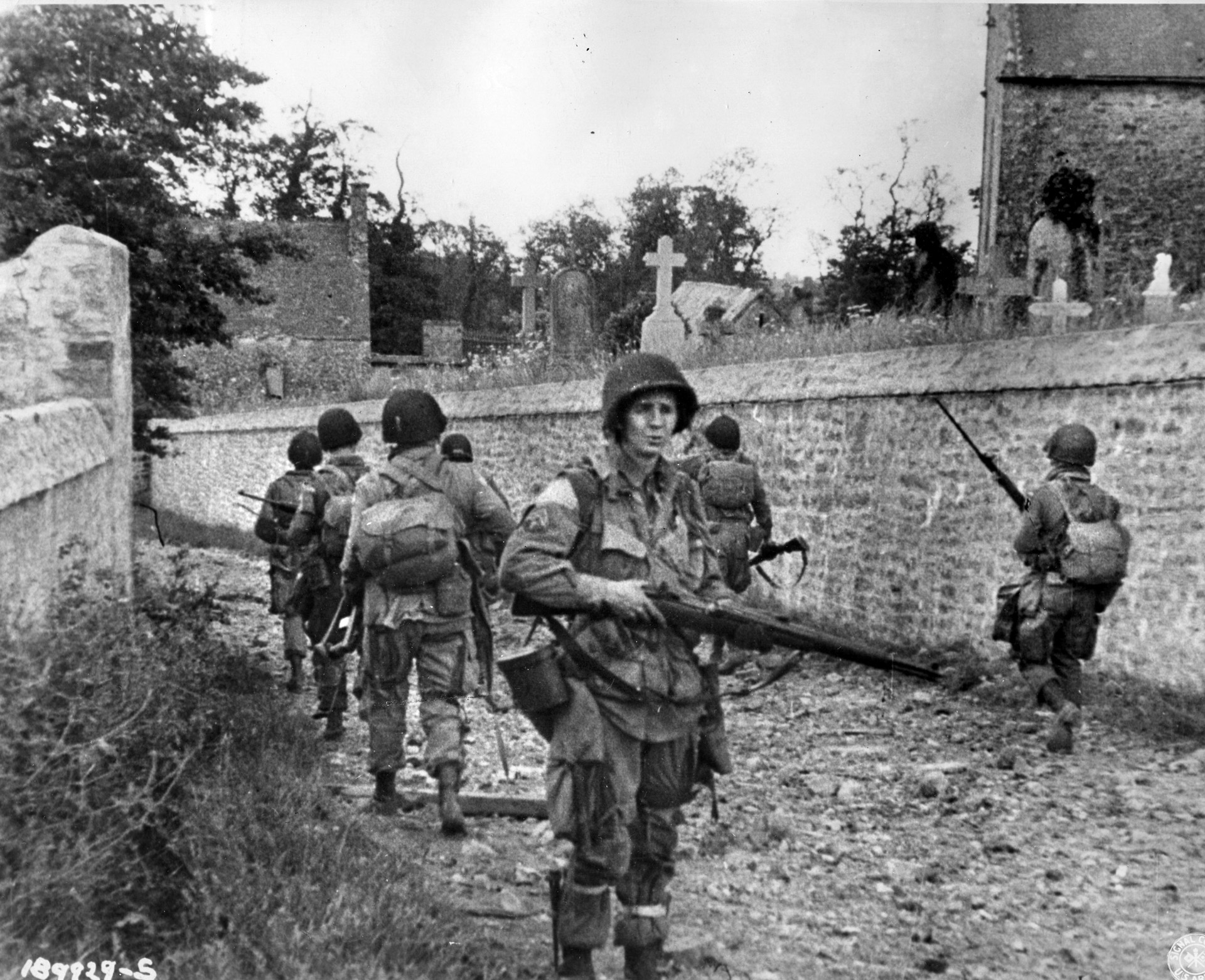
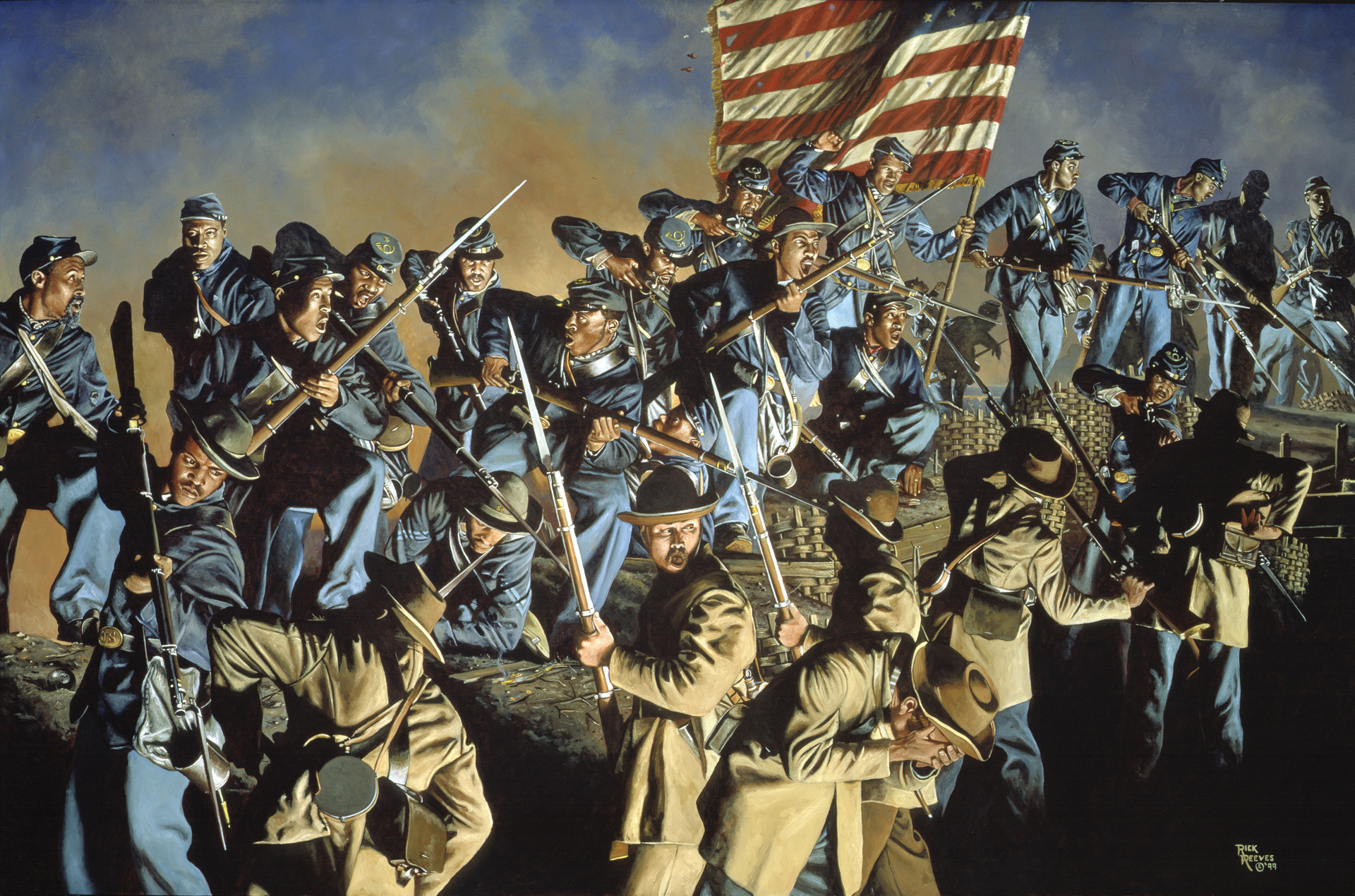
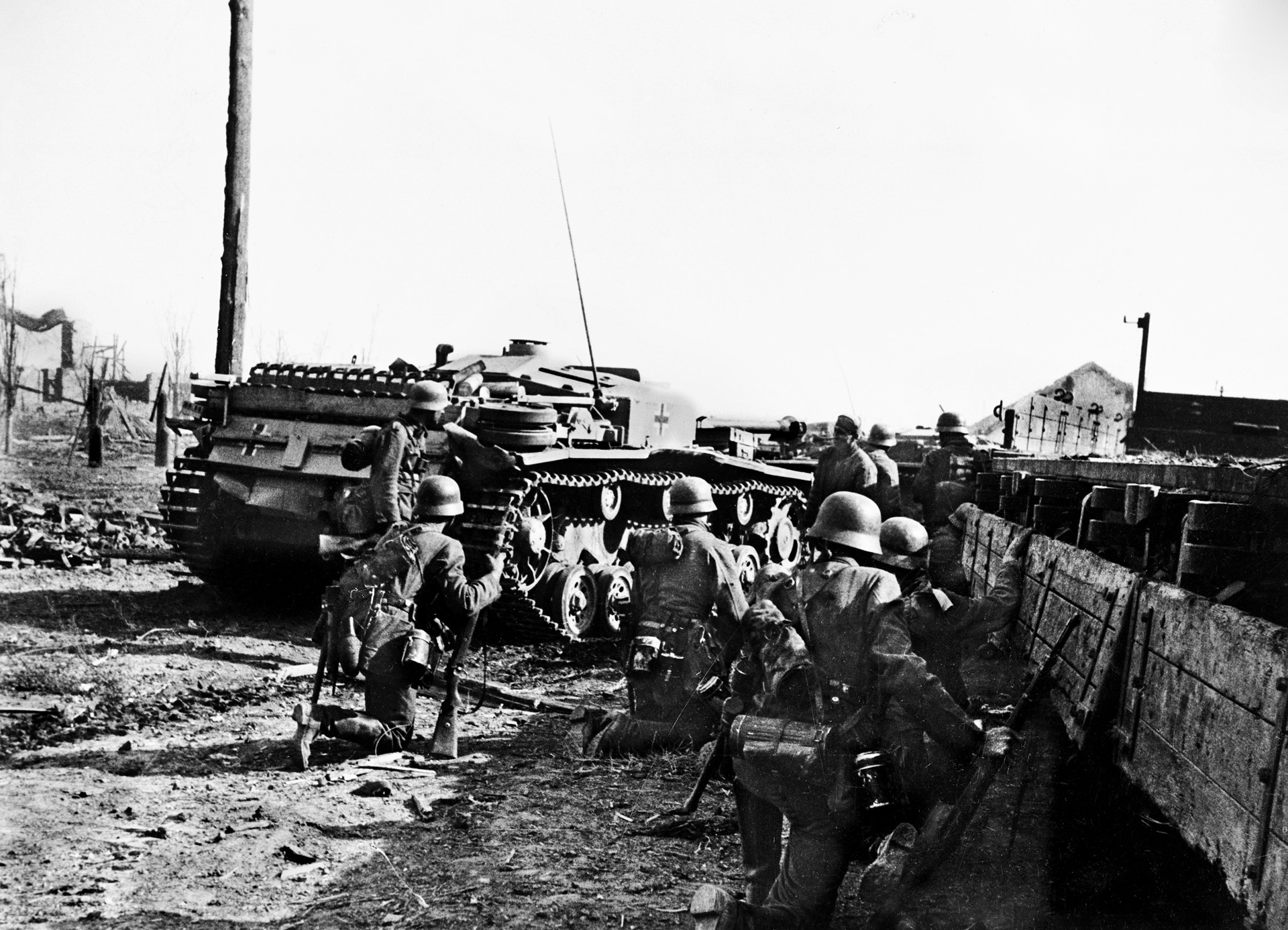
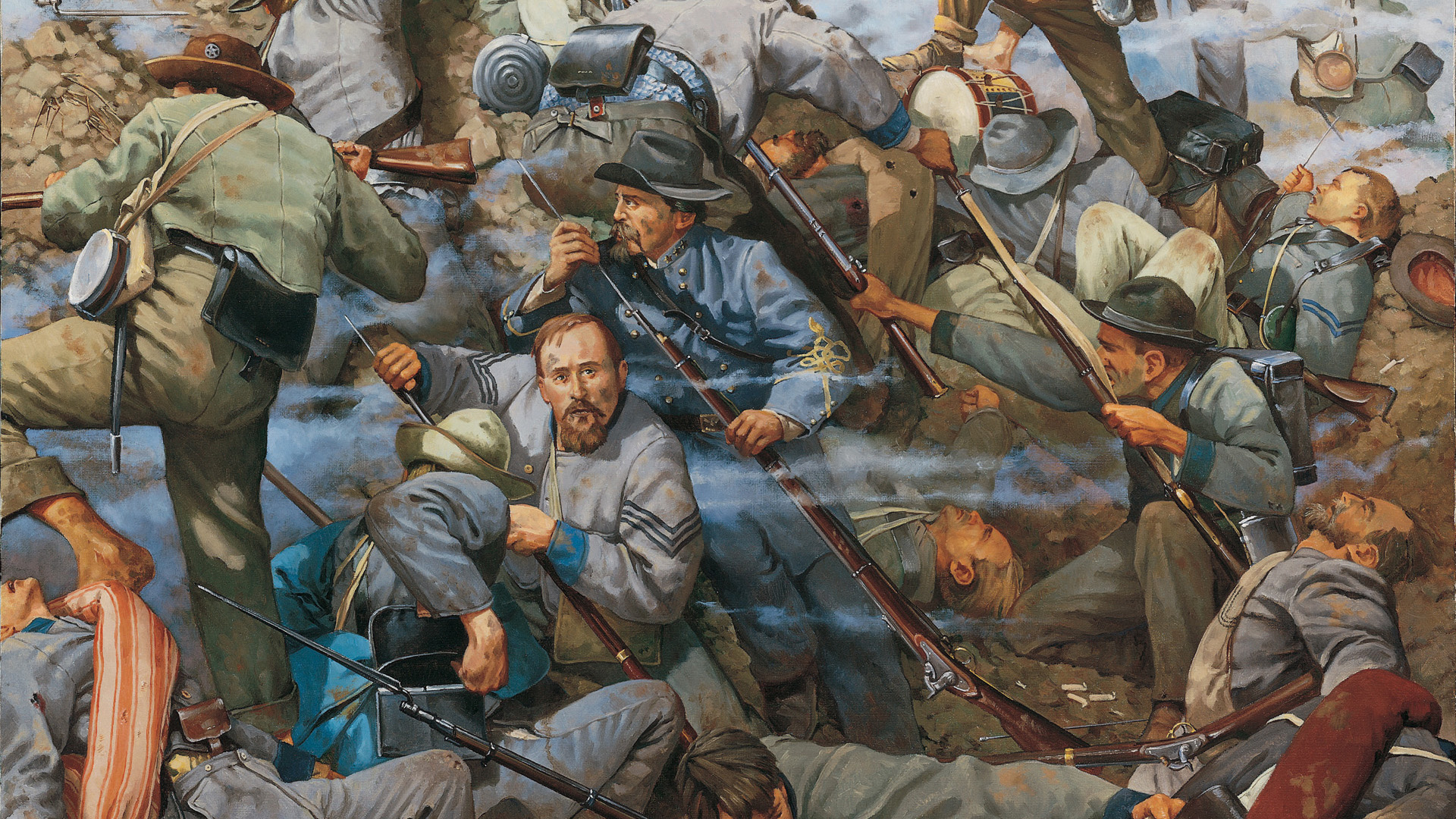
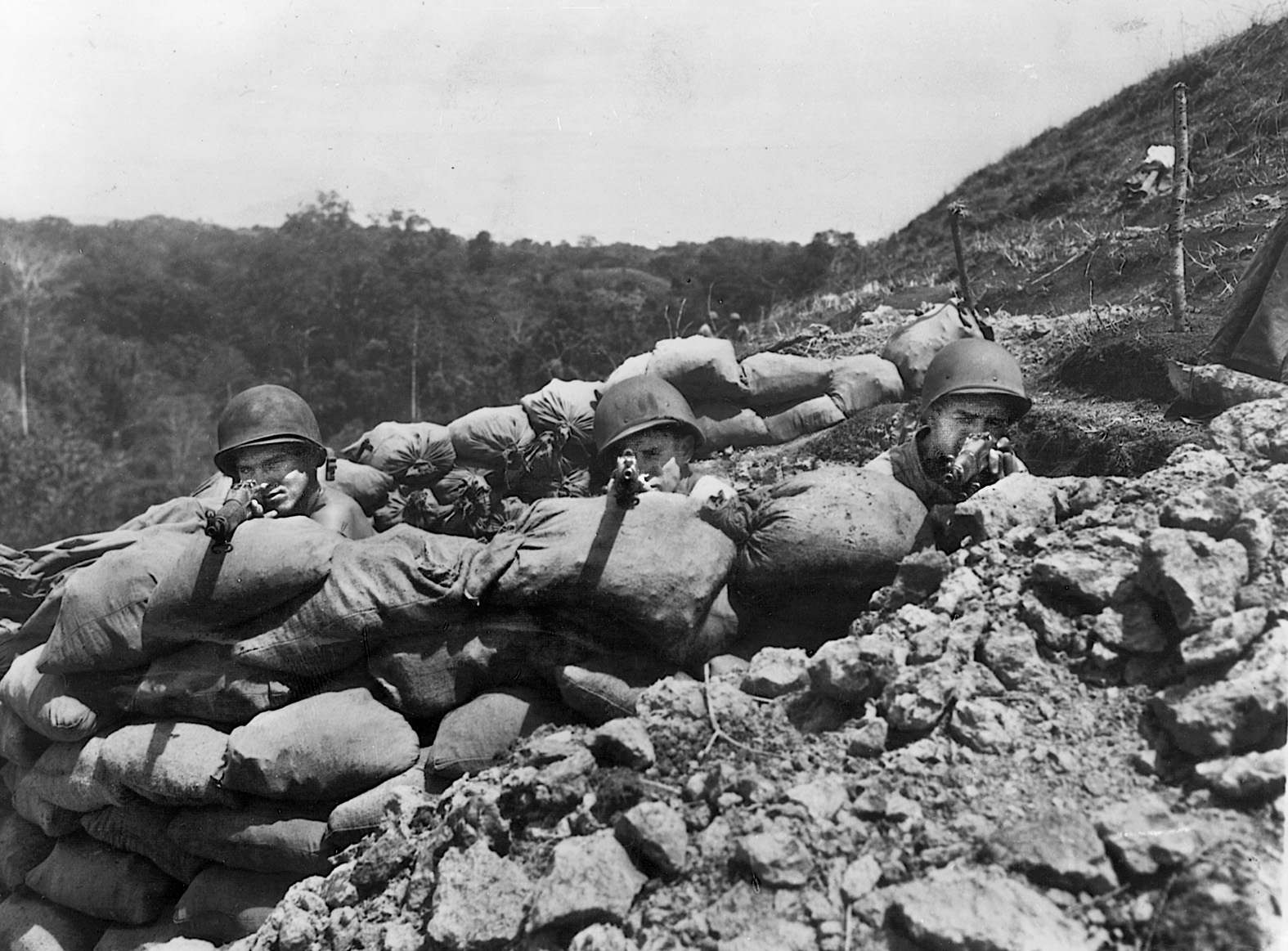
Wow. Would have liked to have met this man. He seemed to be an honorable man overall.